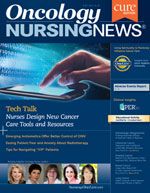The Power of a Good Idea
OncLive Chairman,
Mike Hennessy
In planning this month’s cover story, I have to admit that I wasn’t in the least bit surprised to find that oncology nurses have been seizing on the opportunities technology can offer to improve the care of patients with cancer.
After all, nurses by nature are problem solvers, and they know where the gaps in care frequently occur. They also are often the first practitioner who patients, survivors, and caregivers come to with their questions and concerns. As Sarah Handzel, BSN, RN, writes: “Nurses are skilled at innovating. We have to be.”
In this month’s cover story, we spotlight examples of these innovations, some of which have been nurtured through the entrepreneurial MakerNurse movement, a community of inventive nurses creating solutions to improve patient care through tools, platforms, and training. We also report on a couple of tech-related interventions reported at the recent 2016 Annual Meeting of the American Society of Clinical Oncology (ASCO), that are aimed at systematically identifying patient side effects and signs of possible relapse early, when interventions can make the most difference.
Not to be outdone, nurses at the recent ONS Annual Congress also presented evidence-based projects that use technology to improve the patient experience, such as Google Translate to customize breast cancer treatment plans for non-native English speakers and setting up a user-friendly portal where oncology nurses can retrieve tumor-specific information and resources for their patients and their caregivers.
Improving the patient experience is at the heart of the Integrative Health and Wellness services radiation oncology patients are receiving at the NewYork-Presbyterian/Weill Cornell Lower Manhattan Cancer Center, where the focus, says Manna Lu-Wong, RN, is to provide compassionate, connected care to patients undergoing radiotherapy and thus help them to manage the side effects and stress that often accompany these treatments.
Likewise, chemotherapy-induced nausea and vomiting (CINV) is one of the most common and debilitating side effects of anticancer treatment, and in this issue, we provide an update on several new drugs that are improving the standard of care, particularly in the management of delayed CINV and in patients undergoing highly emetogenic chemotherapy.
Finally, we hear from “The Social Nurse” this month, who showcases our new #CureConnect Twitter chat, a collaboration of Oncology Nursing News and CURE magazine to provide a forum where oncology nurses, patients, caregivers, and advocates can learn from one another and share their combined knowledge.
We hope you will join this conversation, and also share any tech solutions (or non-tech!) you have found helpful in your own practice. Contact our managing editor, Lauren Green (lgreen2@onclive.com) to help us spread the word, and as always, thank you for reading.
—Mike HennessyChairman

Innovative Program Reduces Nurse Turnover and Fosters Development
Published: September 12th 2024 | Updated: September 12th 2024The US Oncology Network (The Network) has developed one of the most comprehensive programs in the nation to support the professional development and retention of new oncology nurses.



